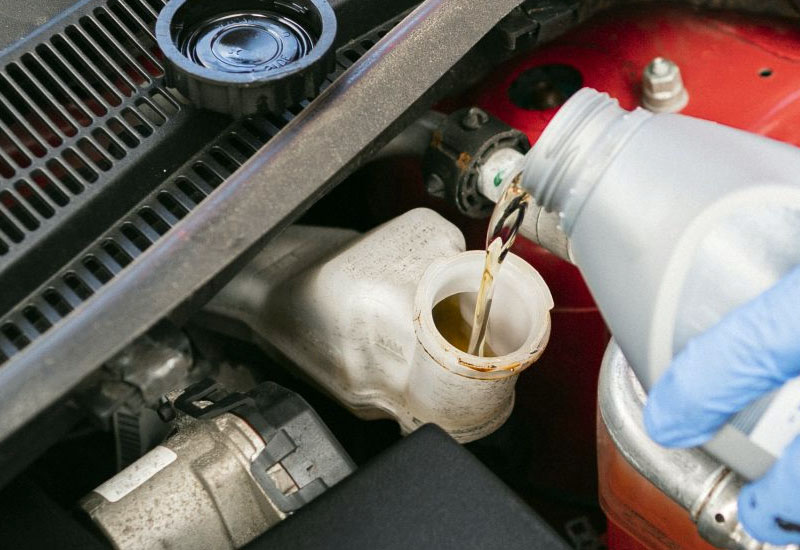Have you ever found yourself in a situation where you have a minor cut or wound and wondered if there are any unconventional methods to speed up the healing process? One such unconventional idea is the use of brake fluid. While it might sound strange and even dangerous, some myths and misconceptions suggest that brake fluid can help in wound healing. In this blog post, we will dive deep into this topic, exploring the facts, debunking the myths, and understanding the science behind wound healing.

The Truth About Brake Fluid and Wound Healing
Let’s begin by addressing the elephant in the room: Can brake fluid really aid in wound healing? To answer this question, it’s crucial to understand what brake fluid is and its intended purpose.
What is Brake Fluid?
Brake fluid is a type of hydraulic fluid used in the brake systems of automobiles. It is essential for the proper functioning of brakes, allowing the transfer of force from the brake pedal to the brake pads, which then slow down or stop the vehicle. Brake fluid is formulated to withstand high temperatures and pressures. It is usually made from a combination of chemicals, including glycols and esters, which help maintain its properties under various conditions.
The Composition of Brake Fluid
Understanding the composition of brake fluid is key to comprehending why it is not suitable for wound healing. Common components of brake fluid include:
- Glycol Ethers: These are solvents that help in reducing the viscosity of the brake fluid. While they are effective in automotive applications, glycol ethers can be harmful if they come into contact with human skin or wounds.
- Borate Esters: These compounds are added to brake fluids to improve their high-temperature stability. Borate esters are also not safe for direct contact with skin, as they can cause irritation and damage to tissues.
- Inhibitors: Brake fluids contain corrosion inhibitors to protect metal parts in the brake system from rust and corrosion. These chemicals are not designed for medical use and can be toxic if applied to wounds.
The Dangers of Using Brake Fluid on Wounds
Given its composition, applying brake fluid to wounds can be extremely harmful. Here are some potential dangers:
- Chemical Burns: The chemicals in brake fluid can cause severe irritation and chemical burns when they come into contact with the skin. This can exacerbate a wound rather than aid in its healing.
- Toxicity: Brake fluid is toxic if ingested or absorbed through the skin. It can cause symptoms such as dizziness, headaches, nausea, and even more severe health issues if absorbed in significant amounts.
- Delayed Healing: Instead of promoting healing, brake fluid can interfere with the natural healing process of the body. The chemicals can damage tissues and slow down the regeneration of skin cells.
Understanding Wound Healing
To appreciate why brake fluid is not suitable for wound healing, it’s helpful to understand how the body heals wounds naturally.
The Stages of Wound Healing
Wound healing is a complex process that involves several stages:
- Hemostasis: This is the initial stage where the body works to stop the bleeding. Blood vessels constrict, and platelets form a clot to seal the wound.
- Inflammation: During this stage, the body sends white blood cells to the wound site to fight off any potential infection. This stage is characterized by redness, swelling, and warmth around the wound.
- Proliferation: In this phase, new tissue forms. The body produces collagen, a protein that helps rebuild the damaged area. New blood vessels also form to supply the healing tissue with nutrients.
- Maturation: This final stage involves the remodeling of the new tissue. The collagen fibers reorganize, and the tissue strengthens over time.
Factors That Aid Wound Healing
Several factors can aid in the natural healing process, including:
- Cleanliness: Keeping the wound clean and free from infection is crucial. This can be achieved by washing the wound with mild soap and water and applying antiseptics if necessary.
- Moisture: Keeping the wound moist can help speed up the healing process. Moist environments prevent the wound from drying out and forming a scab, which can slow down cell growth.
- Nutrition: A healthy diet rich in vitamins and minerals can support the body’s healing process. Vitamins A, C, and E, as well as zinc, play essential roles in wound healing.
- Avoiding Irritants: It’s important to avoid applying any substances to the wound that could cause irritation or allergic reactions. This includes harsh chemicals like those found in brake fluid.
Common Myths and Misconceptions
Despite the clear dangers of using brake fluid on wounds, some myths and misconceptions persist. Let’s debunk some of the most common ones.
Myth 1: Brake Fluid Kills Bacteria
One common myth is that brake fluid can kill bacteria and prevent infections. While it’s true that brake fluid contains chemicals that can kill bacteria, these chemicals are not safe for human use. The harmful effects on skin and tissues far outweigh any potential antibacterial properties.
Myth 2: Brake Fluid Speeds Up Healing
Another misconception is that brake fluid can speed up the healing process. As we’ve discussed, brake fluid contains chemicals that can damage tissues and slow down the natural healing process. There are no scientific studies or evidence to support the claim that brake fluid aids in wound healing.
Myth 3: Mechanics Use Brake Fluid for Cuts
Some people believe that mechanics use brake fluid on their cuts and wounds because they frequently handle the substance. This is not a safe or recommended practice. Any anecdotal evidence of this should be taken with caution, as it can lead to serious health risks.
Safe Alternatives for Wound Care
If brake fluid is not a safe option, what are some safe alternatives for wound care? Here are some recommended practices:
- Clean Water and Soap: Gently cleaning the wound with clean water and mild soap is one of the best ways to prevent infection.
- Antiseptics: Over-the-counter antiseptics like hydrogen peroxide or iodine can be used to disinfect wounds.
- Antibiotic Ointments: Applying an antibiotic ointment can help prevent infections and keep the wound moist.
- Sterile Bandages: Covering the wound with a sterile bandage or dressing can protect it from dirt and bacteria.
- Medical Attention: For more severe wounds, seeking medical attention is always the best course of action.
The Science Behind Wound Healing
To further understand why brake fluid is not suitable for wound healing, let’s delve deeper into the science behind the body’s natural healing process.
Cellular Response to Wounds
When the skin is injured, the body triggers a series of cellular responses to repair the damage. This involves several types of cells, including:
- Platelets: These are the first responders to a wound. They help form a clot to stop bleeding and release growth factors that signal other cells to start the healing process.
- White Blood Cells: These cells, particularly neutrophils and macrophages, are responsible for cleaning the wound site by removing dead tissue and fighting off any potential infection.
- Fibroblasts: These cells produce collagen and other extracellular matrix components that help form new tissue.
- Endothelial Cells: These cells are involved in the formation of new blood vessels, a process known as angiogenesis, which is crucial for supplying the wound with nutrients and oxygen.
The Role of Growth Factors
Growth factors are proteins that play a vital role in wound healing. They regulate various cellular activities, including cell proliferation, migration, and differentiation. Key growth factors involved in wound healing include:
- Platelet-Derived Growth Factor (PDGF): This growth factor attracts fibroblasts and white blood cells to the wound site.
- Epidermal Growth Factor (EGF): EGF stimulates the growth of new skin cells.
- Transforming Growth Factor-Beta (TGF-β): This growth factor helps regulate inflammation and promotes the production of extracellular matrix components.
The Importance of a Balanced Healing Environment
Creating a balanced healing environment is essential for optimal wound healing. This includes maintaining the right temperature, moisture level, and avoiding any potential irritants or harmful substances, such as brake fluid. The body’s natural healing process is highly efficient when supported by appropriate wound care practices.
Potential Complications from Improper Wound Care
Improper wound care, such as using brake fluid, can lead to several complications, including:
- Infection: Harmful chemicals can disrupt the skin’s barrier, making it more susceptible to infections.
- Delayed Healing: Damage to tissues and cells can slow down the healing process, leading to prolonged recovery times.
- Scarring: Improper care can result in increased scarring, as the body may not be able to heal the wound properly.
- Allergic Reactions: Chemical substances can cause allergic reactions, leading to additional complications and discomfort.
I hope this blog post has provided you with a comprehensive understanding of why brake fluid is not suitable for wound healing. The body has a remarkable ability to heal itself when supported with proper wound care practices. Using substances like brake fluid can do more harm than good, leading to potential complications and delayed healing. Always prioritize safe and effective methods for wound care, and seek medical attention when necessary.
Are These Questions in Your Mind?
Is it safe to use household chemicals on wounds?
No, household chemicals are not designed for medical use and can cause harm when applied to wounds. Always use products specifically formulated for wound care.
Can brake fluid cause infections?
Yes, brake fluid can disrupt the skin’s natural barrier and increase the risk of infections due to its toxic and irritating components.
Do I need to see a doctor for minor cuts?
For minor cuts, proper cleaning and care at home are usually sufficient. However, if the wound is deep, won’t stop bleeding, or shows signs of infection, seek medical attention.
Is it true that brake fluid has antibacterial properties?
While brake fluid contains chemicals that can kill bacteria, these chemicals are harmful to human tissues and should not be used on wounds.
Can natural remedies aid in wound healing?
Some natural remedies, such as honey and aloe vera, have antibacterial properties and can aid in wound healing. However, it’s essential to ensure they are used correctly and safely.
Do I need to keep a wound covered?
Keeping a wound covered can protect it from dirt and bacteria and maintain a moist environment that promotes healing. Use sterile bandages or dressings.
Is it normal for a wound to itch while healing?
Yes, itching is a common part of the healing process. It indicates that the wound is healing, but avoid scratching to prevent irritation and infection.
Can improper wound care lead to scarring?
Improper wound care can increase the risk of scarring. Proper cleaning, moisture management, and avoiding irritants can help minimize scarring.
Do I need antibiotics for every cut?
Not all cuts require antibiotics. Over-the-counter antibiotic ointments can help prevent infection in minor cuts, but severe wounds may need medical evaluation for prescription antibiotics.
Is it okay to use hydrogen peroxide on wounds?
Hydrogen peroxide can be used to disinfect wounds, but it can also damage healthy cells. It’s best to use it sparingly and follow up with a gentle, effective wound care regimen.


